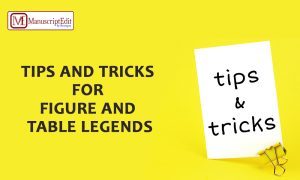A standard manuscript includes an abstract, introduction, methods, results, discussion, and conclusion. It also contains figures and tables visually representing large and complex data, which generally form part of the results section. The data or information from the figures or tables is conveyed via different captions, otherwise known as figure legends and table legends.
Definition
- Table Legends: These are captions for tables with a single phrase or sentence.
- Figure Legends: These are captions for figures which give overall information about the figure represented and are usually longer than table legends.
Purpose of a Legend
- To highlight the importance of the concerned table or figure.
- To aid in analyzing the underlying significance of the findings.
Important Pointers for Describing a Legend┬Ā
- Table legends are placed above any table and generally placed in left alignment. These are usually read top-down, e.g., Table 5.
- A figure legend concludes with a period only, neither a colon, semi-colon, nor a comma, e.g., Figure ABC., and should not exceed 350 words.
- The figure legends are mentioned below any figure, which may represent any image, flowchart, graph, or schematic diagram.
- Data from other sources within the figures or tables should be cited in the legends.
- If a completed experiment is described, the legends are typically written in the past tense. In contrast, a fact or statement from the results and analysis is expressed in the present tense.
- Important details such as the experiment description, the technique or method utilized, the animal model type used, the sample size, the conditions analyzed, and the outcome should all be covered (p-value).
- Legends should be written in full sentences, with the first letter capitalized.
Characteristics of a Figure Legend
- Title: A concise title that is either descriptive (explaining the experiment or technique or a method section) or declarative (stating a result finding) that includes the description of all panels.
- Methods: Methods are limited to the specific technique or experiment in the figure.
- Results: Results are usually given if there is a descriptive title.
- Definitions: This is a description of a figureŌĆÖs features that covers the colors, lines, symbols, patterns, non-standard abbreviations, error bars, and scale bars.┬Ā
Proper Citation of a Legend in The Manuscript
Figure citations are written as Fig 1, Fig. 1, and Figure 1. The panel labels may be written as Fig. 1A, Fig. 1(a), and Figure 1A. These vary according to different journals.
Table citations can be as follows: Table 1, 3, etc. The table legends are never abbreviated in-text. The different portions of a table should also be numbered individually rather than written as Table 1A or Table 1B.
Supplementary figures or tables can be mentioned as Supplementary Fig. 1, Figure S1, Supplementary figure 1, Supplementary table 1, or Table S1.
Important Note:
It is of utmost importance to always follow the journal guidelines for writing the figure and table legends in which it must be submitted.
Conclusion
Knowing how to write the table and figure legends is essential. We hope you found this blog informative. Visit our website https://www.manuscriptedit.com/scholar-hangout/ for more information. You can mail us at support@manuscriptedit.com for your queries. We will be happy to serve you.
Ms. Swati M






